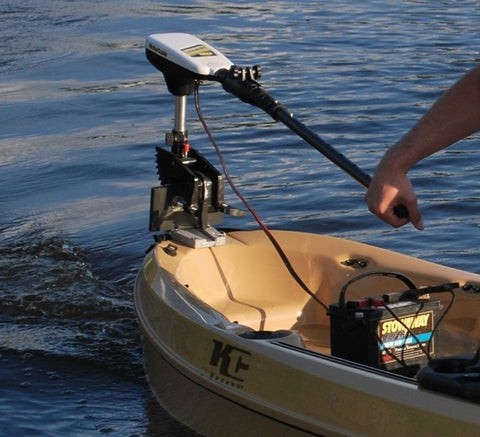The Ultimate Guide to Protecting Your Kayak Motor from Saltwater Corrosion
Man, I learned this lesson the hard way! After watching my first kayak motor deteriorate into a rusty mess within just one season of saltwater fishing, I knew I had to get serious about corrosion prevention. Now, after years of trial and error (and a few expensive replacements), I've finally mastered the art of keeping my motor in pristine condition. Let me share everything I've discovered about protecting your kayak motor from the relentless effects of saltwater.
Understanding the Enemy: Why Saltwater Is So Destructive
You wouldn't believe how quickly saltwater can wreak havoc on a motor! During my first year of kayak fishing in the bay, I watched in horror as my beautiful new motor developed crusty white deposits and reddish-brown spots within weeks. Here's the thing - saltwater is basically kryptonite for metals. When salt dissolves in water, it creates an electrolyte solution that accelerates the oxidation process. This means your motor's metal components start breaking down faster than a chocolate bar in the summer sun!
The real kicker is that saltwater corrosion doesn't stop even after you're done paddling. The salt crystals left behind continue to attract moisture from the air, creating an endless cycle of corrosion. I've seen perfectly good motors turn into rust buckets just sitting in the garage because they weren't properly cleaned after their last saltwater adventure.

Essential Pre-Treatment Steps
Before you even think about hitting those salty waters, you've got to prep your motor properly! I remember skipping this step when I first started out - boy, was that a mistake that cost me dearly. Now, I make sure to treat every inch of my motor before it goes anywhere near saltwater.
Start with a quality marine-grade primer - and don't cheap out on this stuff! I used to try saving a few bucks on bargain primers, but trust me, you'll end up paying way more in replacement costs. Apply at least two coats of primer to all metal surfaces, paying special attention to connections and joints where saltwater loves to hide.
After the primer dries completely (give it a full 24 hours, even if the can says it dries faster), apply a marine-grade anti-corrosive paint. Here's a pro tip I discovered through countless hours of research and experimentation: zinc-chromate primers work wonders as an additional protective layer between your regular primer and paint.
Daily Maintenance Routine
Look, I know you're probably thinking, "Daily maintenance? Ain't nobody got time for that!" That's exactly what I used to say until I realized how much money and headache a quick daily routine could save. After each use in saltwater, I follow these steps religiously:
First thing I do is flush the motor with fresh water immediately after use. Don't wait until you get home - I keep a couple of gallons of fresh water in my car just for this purpose. Pay special attention to all the nooks and crannies where salt can hide. Sometimes I'll even use a soft brush to really get in there and make sure I'm not missing any spots.
Once I'm home, I do a more thorough freshwater rinse and then use a water displacing spray on all metal parts. This stuff is like liquid gold for preventing corrosion! Make sure you get good coverage in all those hard-to-reach spots. I learned this lesson after finding rust in places I didn't even know could rust!

Long-Term Protection Strategies
Over the years, I've developed some solid strategies for keeping my motor protected during long-term storage. The first winter I owned a kayak motor, I just threw it in the garage without any special preparation. Come spring, I had myself a very expensive paperweight! Now I know better, and my motors last for years instead of months.
The key to long-term protection is creating a barrier between your motor and the elements. I start by applying a thick coat of marine-grade grease to all moving parts. Then I use a heavy-duty corrosion inhibitor on all exposed metal surfaces. Some folks think this is overkill, but I've never had to replace a properly protected motor.
For storage, I keep my motor in a climate-controlled space whenever possible. If that's not an option, I use moisture-absorbing packets and a breathable cover. This setup has worked wonders for preventing moisture buildup during those humid summer months.
Signs of Corrosion and Early Intervention
Let's talk about catching problems before they become disasters. I've become something of an expert at spotting the early warning signs of saltwater damage, mostly because I ignored them so many times in the past! The first sign is usually a whitish powder forming on metal surfaces - that's salt residue, and it's your cue to take action immediately.
If you spot any reddish-brown spots, that's rust already setting in. Don't panic though! If you catch it early enough, you can usually save the affected area with some careful cleaning and restoration. I use a wire brush to remove surface rust, followed by a rust converter product that actually transforms the rust into a protective coating.
Conclusion
Protecting your kayak motor from saltwater corrosion isn't just about preserving your investment - it's about ensuring reliable performance when you're out on the water. Through years of experience (and more than a few costly mistakes), I've learned that prevention is always better than cure when it comes to saltwater corrosion. By following these guidelines and staying vigilant with maintenance, you can keep your motor running smoothly for years to come.
Remember, the key is consistency in your maintenance routine. Don't skip steps or take shortcuts - believe me, I've tried, and it never ends well! Share your own corrosion prevention tips in the comments below, and let me know if these strategies have helped keep your kayak motor in top condition.
